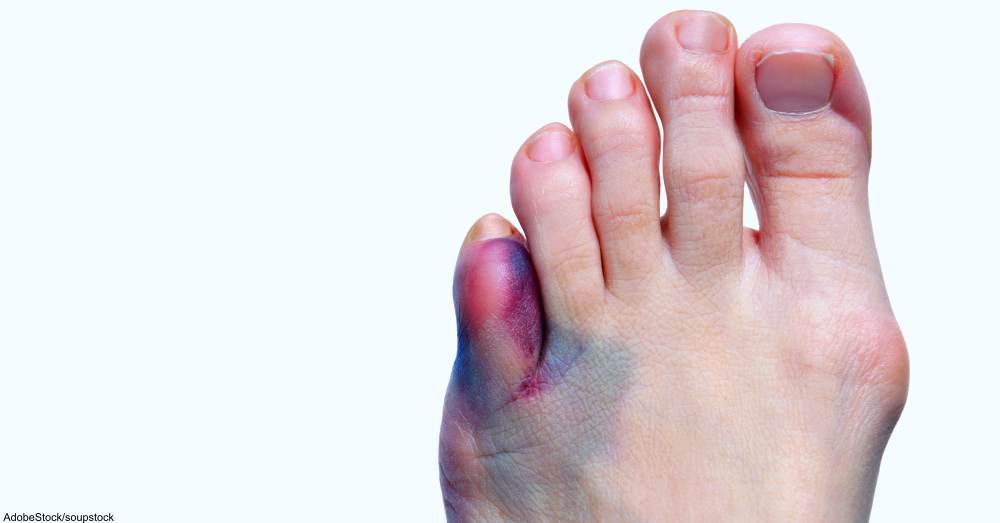Why Are My Feet Purple?
Katie Taylor
Human skin comes in a range of amazing colors, but purple? Not so much.
If you look down to notice your toes or feet are departing from their normal shade and heading for shades of blue, green, or even eggplant, it's likely a sign of some sort of circulation problem. When blood flow is blocked, oxygen can't get to your extremities and your hands and and feet may start to look blue or purple. The technical term for this blue-toned trend is cyanosis, and it can be caused by a number of things ranging from mild to severe.
Here are 7 things that can cause your feet to go purple:
1. Bruise or injury
If you've recently stubbed your toe or injured your foot, bruising and discoloration is normal. You'll want to check in with your doctor if the injury doesn't heal in a reasonable amount of time. Diabetes can cause wounds to heal more slowly, putting someone at risk for ulcers.
 Photo: AdobeStock/cegli
Photo: AdobeStock/cegli
2. Raynaud's syndrome
Raynaud's syndrome causes temporary spasms and constriction of the blood vessels in the hands and feet. This blocks blood flow, causing discoloration. Someone with Raynaud's syndrome may notice their extremities turning blue, purple, red, or white.
Raynaud's disease causes pain and numbness in the affected areas, and it can be triggered by cold temperatures, anxiety, or stress. Symptoms are usually short, and keeping hands and feet dry and warm and reducing stress can help minimize attacks. It may also be a symptom of another health condition.
 Photo: AdobeStock/twinschoice
Photo: AdobeStock/twinschoice
3. Peripheral artery disease
Peripheral artery disease (PAD), also called peripheral arterial disease or peripheral vascular disease, causes blood flow in the hands and feet to decrease due to the narrowing of blood vessels because of cholesterol buildup. People with diabetes are more likely to have to deal with PAD because of the damaging effects of high blood sugar.
The reduced blood flow may cause bluish or purplish discoloration in the hands or feet, slow wound healing, pain, numbness or tingling, and cold hands and feet.
 Photo: AdobeStock/nebari
Photo: AdobeStock/nebari
4. Deep vein thrombosis
Deep vein thrombosis (DVT) occurs when a blood clot forms in one of the body's deep veins, often in the legs. It doesn't always present with symptoms, but noticeable symptoms include leg pain or swelling, red, blue, or purple discoloration, and/or heat in the affected area.
It's important that you see a doctor about deep vein thrombosis, because the blood clot causing it could potentially travel to your one of your lungs and cause a pulmonary embolism, a life-threatening condition.
5. Frostbite
Keep those toes warm! Frostbite occurs when skin and underlying tissues freeze. It's most common on areas of exposed skin: ears, hands, cheeks, toes, and skin. But any skin can get frostbite if it gets cold enough.
Frostbite starts when the skin becomes red and cold, and then hard, numb, and pale. After the damage is done the skin can appear blue, gray, or purple. Frostbite can cause permanent tissue damage. Risk for frostbite is increased in people with diabetes, PAD, Raynaud's disease, or those who have had frostbite in the past.
6. Critical Limb Ischemia/Ischemic Foot
Critical limb ischemia (CLI), happens when there is a severe blockage in the arteries in the feet or legs. It's a serious complication of peripheral artery disease and is a chronic condition that causes pain in the feet or toes even during rest. Someone with CLI can experience severe pain, sores that don't heal, pain or numbness, thickening of the toenails, discoloration, or skin that is dry, smooth, and shiny. CLI may also cause dry gangrene.
Untreated, complications of CLI can lead to amputation.
 Photo: Adobe Stock/wingedwolf
Photo: Adobe Stock/wingedwolf
7. Lupus
Lupus is an autoimmune disease that causes your immune system to attack your tissues and organs. The resulting inflammation can affect your joints, skin, kidneys, blood cells, brain, lungs, and heart. Symptoms vary and are often similar to other conditions. A facial rash occurs in most, but not all, cases.
Those who have lupus often suffer from episodes or flares when their symptoms get worse. Symptoms may include, fatigue, fever, join pain, rash across the face or on other parts of the body, skin lesions, shortness of breath, dry eyes, chest pain, headaches, confusion, and fingers and toes that turn white or blue when exposed to cold or during times of stress.
While we encourage you to see your doctor early and often in the case of any strange symptoms, purple feet isn't always cause for alarm. It may be you just need a cozier pair of socks! A good strategy is to check on your feet every day so you know what's normal for you and if there's anything off. Take care of those feet—and all the rest of you, too!


